Cultivars - A
Cultivars - B
Cultivars - C
Cultivars - D
Cultivars - E
Cultivars - F
Cultivars - G
Cultivars - H
Cultivars - I
Cultivars - J
Cultivars - K
Cultivars - L
Cultivars - M
Cultivars - N
Cultivars - O
Cultivars - P
Cultivars - QR
Cultivars - S
Cultivars - T
Cultivars - UV
Cultivars - W
Cultivars - XYZ
| |
|
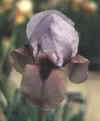 TATTLETALE (McAllister, 1998) OGB On opening, the soft violet standards and the
greyed-violet falls have an intense smoky overlay. In full sun, it gradually fades to tattletale grey which just makes its large, near-black, and appropriately tongue-shaped signal all the more noticeable. Some love it. Some hate it. But few pass it without comment especially since it got its name. Edith Seligmann X (Martha Mia x Moon Dust). TATTLETALE (McAllister, 1998) OGB On opening, the soft violet standards and the
greyed-violet falls have an intense smoky overlay. In full sun, it gradually fades to tattletale grey which just makes its large, near-black, and appropriately tongue-shaped signal all the more noticeable. Some love it. Some hate it. But few pass it without comment especially since it got its name. Edith Seligmann X (Martha Mia x Moon Dust). |
|
TERRY ANN (Campbell, 1960) OB- Powder blue with deeper flecks; pale yellow beard. Purissima X Capitola. |
|
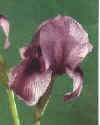 THESEUS (Van
Tubergen, NR) RC Parentage unknown, but obviously involving the regelia species I. korolkowii and an
onco. Not eligible for shows because it wasnt registered, but an excellent garden subject and valuable breeder. THESEUS (Van
Tubergen, NR) RC Parentage unknown, but obviously involving the regelia species I. korolkowii and an
onco. Not eligible for shows because it wasnt registered, but an excellent garden subject and valuable breeder.
|
|
 THINE THE GLORY (Hunt, 1987) OGB+ Sparkling medium-violet
bitone. Presumably triploid, from Martha Mia X (I. samariae x Judean Charmer). Has produced a few seeds, which I've cultured, but none of them have survived to bloom size. Although Gene kept meticulous garden records, he hadn't anticipated being struck by a drunk driver, or expected someone else to have to interpret his notes and labels. When I found this seedling, it didn't have a selection number but from his records it appeared to be one of the seedlings he had designated as ready for final evaluation. Further study of the garden records, however, showed that it and a sib (Prodigal Son) were actually two previously-unaccounted-for selected seedlings. I was most grateful for finding it, of course, and adapted lyrics to give credit where credit was due. THINE THE GLORY (Hunt, 1987) OGB+ Sparkling medium-violet
bitone. Presumably triploid, from Martha Mia X (I. samariae x Judean Charmer). Has produced a few seeds, which I've cultured, but none of them have survived to bloom size. Although Gene kept meticulous garden records, he hadn't anticipated being struck by a drunk driver, or expected someone else to have to interpret his notes and labels. When I found this seedling, it didn't have a selection number but from his records it appeared to be one of the seedlings he had designated as ready for final evaluation. Further study of the garden records, however, showed that it and a sib (Prodigal Son) were actually two previously-unaccounted-for selected seedlings. I was most grateful for finding it, of course, and adapted lyrics to give credit where credit was due. |
|
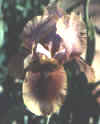 THINGS TO COME (McAllister, 1993) OGB+ A harbinger of coming attractions in the near-arils, both flower and plant. Standards have gold filigree around the edge of an amethyst ground. Golden ground of falls shows only the edge, with center complete covered with deep ruby red. It was the forerunner of a type of 3/4-breds that are proving more
gardenable. I wasn't the first to introduce an unbalanced tetraploid 3/4-bred, of course, but there haven't been enough of them for the group to gain popularity as a whole. This one comes from Balalaika Music X Thunderstorm, and has the excellent growth habits of its I. hoogiana heritage. Limited fertility with tetraploid arils, none in tests with
halfbreds. Members of the IRIS-L may recognize this as the one Clarence Mahan dubbed "Fleur de Puce". THINGS TO COME (McAllister, 1993) OGB+ A harbinger of coming attractions in the near-arils, both flower and plant. Standards have gold filigree around the edge of an amethyst ground. Golden ground of falls shows only the edge, with center complete covered with deep ruby red. It was the forerunner of a type of 3/4-breds that are proving more
gardenable. I wasn't the first to introduce an unbalanced tetraploid 3/4-bred, of course, but there haven't been enough of them for the group to gain popularity as a whole. This one comes from Balalaika Music X Thunderstorm, and has the excellent growth habits of its I. hoogiana heritage. Limited fertility with tetraploid arils, none in tests with
halfbreds. Members of the IRIS-L may recognize this as the one Clarence Mahan dubbed "Fleur de Puce". |
|
THUNDERSTORM (Flanagan, 1981) OGB Light violet standards, golden tan falls blended to rosy violet in the throat. Dark red-violet signal; near-black beard. Esther the Queen X Sib to Desert Dove. A fully fertile halfbred that is a strong grower, one of my favorite "podders", and an excellent parent for those mix-up-the-genes-to-see-what-happens crosses. I recommend it highly for beginners. |
|
TINY PIRATE (Rich, 1990). OGB Lavender-purple bitone, inconspicuous veining on falls; bold, dark purple signal. Seedling involving I. antilibanotica, I. korolkowii (brown & green), and Judean Cream X (I. pumila seedling 51-38 x Little
Charmer). I have found no chromosome count on this one, but its classification
as an OGB during this period suggests that it may have passed fertility
tests and be a tetraploid instead of the expected triploid. |
|
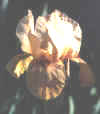 TOLDJASO (McAllister, 1993) OGB+ Standards have golden yellow veins on buff ground; falls have fine rust veins on yellow ground. Presumably triploid, from Child of God X Persian Embroidery. It's an unusually good pollen parent for its type, giving superior substance to its offspring. I've used it primarily for yellows and yellows marked with rust, but it's also given me an excellent, sun-resistant reddish-brown. In case it's not obvious, the name is a contraction of "Told You So". I have favored using the aril as the pod parent, of course, but the flowers don't always cooperate. Gus believed that it was better to make the reverse cross than not to make the cross at all. This was from Child of God X Persian Embroidery a cross I wouldn't have made without his prompting and this is presumably triploid but has an unusual degree of fertility. Standards have golden yellow veins on buff ground; falls have fine rust veins on yellow ground. TOLDJASO (McAllister, 1993) OGB+ Standards have golden yellow veins on buff ground; falls have fine rust veins on yellow ground. Presumably triploid, from Child of God X Persian Embroidery. It's an unusually good pollen parent for its type, giving superior substance to its offspring. I've used it primarily for yellows and yellows marked with rust, but it's also given me an excellent, sun-resistant reddish-brown. In case it's not obvious, the name is a contraction of "Told You So". I have favored using the aril as the pod parent, of course, but the flowers don't always cooperate. Gus believed that it was better to make the reverse cross than not to make the cross at all. This was from Child of God X Persian Embroidery a cross I wouldn't have made without his prompting and this is presumably triploid but has an unusual degree of fertility. Standards have golden yellow veins on buff ground; falls have fine rust veins on yellow ground. |
|
 TOP MENTION (Peterson, 1978) OGB Dove grey standards, antique gold falls, bronze beard.
This photo was taken as the flower opened, before the reddish blush had faded to
reveal its antiqued gold tones. With sunfast reds, it has produced some of the most intense jewel tones I've ever seen. Highly recommended if you can get your hands on it. Merriglow X (Card of Thanks x Tuesday Song). TOP MENTION (Peterson, 1978) OGB Dove grey standards, antique gold falls, bronze beard.
This photo was taken as the flower opened, before the reddish blush had faded to
reveal its antiqued gold tones. With sunfast reds, it has produced some of the most intense jewel tones I've ever seen. Highly recommended if you can get your hands on it. Merriglow X (Card of Thanks x Tuesday Song). |
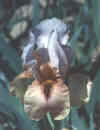 TOPPED WITH CREAM (McAllister, 1992) OGB Creamy white standards. Chrome-yellow falls have a pale pinkish blush and almost solid burgundy veining in the signal area. A nice surprise from a cross (Desert Princess X Rose of Sharon) made for pinkish shades! Proven fertile but I have nothing to report because I've given away most of its seeds. The obvious name for this one would have been Banana Cream Pie but that was already taken, so I had to settle for a less picturesque, but still accurate, description. TOPPED WITH CREAM (McAllister, 1992) OGB Creamy white standards. Chrome-yellow falls have a pale pinkish blush and almost solid burgundy veining in the signal area. A nice surprise from a cross (Desert Princess X Rose of Sharon) made for pinkish shades! Proven fertile but I have nothing to report because I've given away most of its seeds. The obvious name for this one would have been Banana Cream Pie but that was already taken, so I had to settle for a less picturesque, but still accurate, description. |
|
TORNADO WARNING (Flanagan, 1987). OGB Lightly ruffled medium violet, dark violet signal; black beard; slight fragrance. High Frontier X Heart Stealer.
Fully fertile and one of my favorite Flanagan breeders. |
|
TORNADO WATCHER (Wilson, 1992). OGB S. orchid-pink veined light blue, darker at rib; F. tan and light rose blend, maroon dotting at hafts, large semi-circular maroon signal; grey-cream beards; slight sweet fragrance. Onlooker X Tornado Warning. |
|
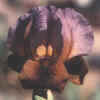 TRIBE OF JUDAH (Hunt, 1984) OGB+ Lilac standards are flushed golden brown at the base; falls are golden brown with dark brown spot. Presumably triploid, from ((Sojourn x Almost) X (I. samariae x I. nigricans)) but it's one of my favorite near-aril parents. Its pollen is unusually potent for its type. Crossed onto TBs from recessive lines, it has even produced some quite impressive quarterbreds including some with arilbred-style signal spots, like Magnificent Obsession. It will occasionally, if somewhat reluctantly, pod to half-breds. It surprised me this year by podding generously to tetraploid aril pollen. I recommend it highly for beginners and experimenters alike. Gene named this one himself. Judah was, of course, one of the twelve Hebrew tribes. TRIBE OF JUDAH (Hunt, 1984) OGB+ Lilac standards are flushed golden brown at the base; falls are golden brown with dark brown spot. Presumably triploid, from ((Sojourn x Almost) X (I. samariae x I. nigricans)) but it's one of my favorite near-aril parents. Its pollen is unusually potent for its type. Crossed onto TBs from recessive lines, it has even produced some quite impressive quarterbreds including some with arilbred-style signal spots, like Magnificent Obsession. It will occasionally, if somewhat reluctantly, pod to half-breds. It surprised me this year by podding generously to tetraploid aril pollen. I recommend it highly for beginners and experimenters alike. Gene named this one himself. Judah was, of course, one of the twelve Hebrew tribes. |
|
TSLIL (Shahak, 1993). OH S. dark purple (RHS 77A); F. red-purple (RHS 52A), yellow-orange signal; black-purple beards. I. samariae X (I. mariae x I. hermona). |
|
TUL KEREM (Danielson, 1974). OGB+ S bright blue, strong veining, giving appearance of stripes; F same with heavier veining; brown beard; bright blue styles finely veined. (Saffron Charm x Jallah ad-Din) x I. atropurpurea. |
|
TURKESTAN (Hager, 1986). OGB S deep purple; deep amber style crests; F deep red, diffused black signal; black beard. (Welcome Reward x Capitola) X Grand Vizier. |
|
TURKISH DANCER (ASI, 1983) R Pale lilac, blended violet and brown, blue beard. A variant of I. stolonifera,
reportedly selected by Lloyd Austin. |
|
TURKISH FEZ (Hager, 1984). S deep rose-amethyst; F Chinese lacquer red, black signal; black-bronze beard: Chinese lacquer red style crest.
I've used this in quest of both reds & pinks. Red because of its
appearance, pink because it may carry one dose of the t-factor. AR29838Sh: (Welcome Reward x Capitola) X
Merriglow. |
|
TURKISH HEART (Shockey, 1990). OGB S. white, midrib flushed citrine yellow; F citrine yellow, large heart-shaped brown signal; yellow beard. Complex pedigree. |
|
TURKISH HERALD (Shockey, 1992). OGB S. light purple violet (near RHS 82D), midrib flushed buff; F. buff orange (near 24D), recurved, large sharply defined near-black signal; bronze beard; slight sweet fragrance. Turkish Pendant X 85-125-B: (Ruthie x Dawn Cascade). |
|
TURKISH PENDANT (Shockey, 1990). OGB S white lightly flushed violet; F golden yellow, large half-moon brown signal; golden yellow beard; sweet fragrance. ). 84-111-6A: (((Stars Over Chicago x Welcome Reward) x Syrian Moon) x (Heart Stealer x (Stars Over Chicago x Welcome Reward))) X Onlooker. |
|
TURKISH TANGENT (Hager 1984). OGB S amethyst, beige midrib; beige style arms and crest; F deep plush red, distinct edge of beige; dark red beard and signal. AR2838Sh: (Welcome Reward x Capitola) X
Merriglow. |
|
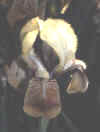 TURKISH TOPAZ (Austin, 1962). S blue-white with amber-yellow edge; F yellow-brown with some purple striations; blue beard.
Its true parentage is not known. The Court of Iris catalog listed it as being from two I. stolonifera seedlings, which would make it an R under either
system by today's terminology. At the time, however, "I. stolonifera seedling"
meant that one parent was I. stolonifera, but not necessarily
both. It has not crossed with the I. stolonifera
clones I've tried and its growth habits are
certainly those of an RB, but its flower is so much like the yellow form
of I. stolonifera that two two have become mixed up in
distribution. TURKISH TOPAZ (Austin, 1962). S blue-white with amber-yellow edge; F yellow-brown with some purple striations; blue beard.
Its true parentage is not known. The Court of Iris catalog listed it as being from two I. stolonifera seedlings, which would make it an R under either
system by today's terminology. At the time, however, "I. stolonifera seedling"
meant that one parent was I. stolonifera, but not necessarily
both. It has not crossed with the I. stolonifera
clones I've tried and its growth habits are
certainly those of an RB, but its flower is so much like the yellow form
of I. stolonifera that two two have become mixed up in
distribution. |
|
TWILIGHT DANCER (Danielson, 1971). OGB+ S white; F dark maroon-brown, bright tan beard. ((Jallah Effendi x Kalifa Baltis) x Tatai Pasha) X Persian Embroidery. |
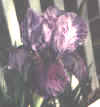 TWILIGHT RAIN (Peterson, 1992). OGB- Registered as S light violet
with darker sprinkles; F light violet washed purple-violet; brown beards tipped
dark violet; but I'd describe it as a variegated flower. A quarterbred
from ((Amada Sings x Jealous Lover) x Stitched Beauty X Heart Stealer.
This has proven far more effective than any TB for use with tetraploid aril
partners and has produced a number of gardenable, fully-fertile functional
halfbreds in the first generation. TWILIGHT RAIN (Peterson, 1992). OGB- Registered as S light violet
with darker sprinkles; F light violet washed purple-violet; brown beards tipped
dark violet; but I'd describe it as a variegated flower. A quarterbred
from ((Amada Sings x Jealous Lover) x Stitched Beauty X Heart Stealer.
This has proven far more effective than any TB for use with tetraploid aril
partners and has produced a number of gardenable, fully-fertile functional
halfbreds in the first generation. |
|
TZOR (Shahak, 1986). OH S light purple, veined darker, dotted purple in center; purple styles; F light purple lightly veined slightly darker and heavily dotted slightly darker, dark purple signal; yellow beard. ((I. mariae x I. haynei )x I. samariae) X I. urmeinsis hybrid.
|
|